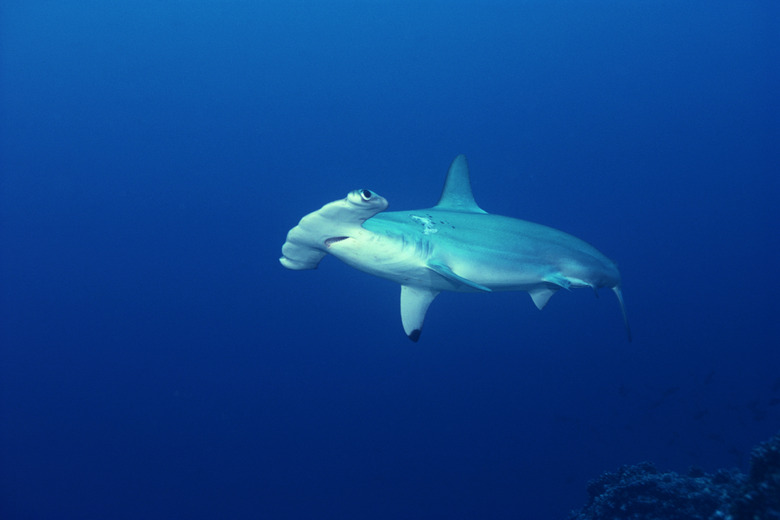How Does A Hammerhead Shark Protect Itself?
Hammerhead sharks (genus Sphyrnidae) are fascinating thanks to their elongated head that gave it its name. These sharks can grow anywhere between 13 and 20 feet in length, which makes them some of the largest carnivorous fish in the seas today.
Like other medium- and large-sized sharks, hammerheads are almost always at the top of the food chain with few predators hunting them.
But, they certainly aren't immune to predation. In order to avoid being eaten, protective hammerhead adaptations have evolved over thousands of years in order to give these animals an edge over any potential predator that crosses their path.
Hammerhead Shark Predators
Hammerhead Shark Predators
While large sharks like the hammerhead have few natural predators, there are a few that can and will attack these sharks. The biggest predator and threat to hammerheads are humans.
Certain species of these sharks are on the endangered species list with fishing, climate change and accidental human kills (nets, pollution, etc) as some of the main reasons why.
Scientists have also observed cannibalism with hammerheads. Larger and older hammerhead sharks can and will attack and eat baby hammerhead sharks. Young hammerheads may also be preyed on by other large sharks.
Hammerhead Shark Protection in Numbers
Hammerhead Shark Protection in Numbers
Most shark species are solitary, independent animals. Some species of hammerhead, though, swim together in schools. Not all hammerheads do this, but scalloped hammerheads (Sphyrna lewini) and the great hammerhead (Sphyrna mokarran) have been observed swimming in large schools in various locations.
These schools of hammerheads can include hundreds of individual sharks. Some of the largest schools are estimated to have more than 500 hammerhead sharks.
This provides a level of protection in that predators are not as likely to attack large schools of this size. If the school is attacked, being a part of a large group provides protection to individual sharks as they're less likely to be specifically targeted than if they were alone, for example.
Bodily Defenses and Weapons
Bodily Defenses and Weapons
Some of the most important hammerhead shark protection methods simply have to do with the size and body of the shark.
The large size of these sharks (with some growing to 20 feet long!) makes them a hard target and as such are usually avoided by other predators. Their thick sandpaper-like skin also makes them difficult to attack or harm, which also makes them difficult prey.
Their teeth gives them some offensive protection. Hammerheads can be quite aggressive when threatened and they can use one of their hundreds of 3/4-inch razor sharp teeth to easily tear through most predators that may threaten them.
Wide Field of Vision
Wide Field of Vision
Thanks to the unique shape of their heads and the placement of their eyes on either side, hammerhead sharks have a much wider and better field of vision compared to other shark and predator species. This makes any potential threats easier to spot and avoid, not to mention how it helps them find prey easier and quicker.
This is also somewhat unique for sharks that usually don't have the best vision compared to their other senses.
Aerodynamic and Maneuverable
Aerodynamic and Maneuverable
Hammerhead sharks have adapted to have sleek and aerodynamic bodies. This allows them to not only swim fast (at speeds clocked at 25 miles per hour), but it also allows them to make quick and sharp turns to both catch prey and avoid predators.
This also gives young hammerheads an advantage over older and larger hammerheads, which is important considering older hammerheads often prey on baby hammerhead sharks. The increased agility and ability to out-maneuver large predators is essential, especially for the juvenile hammerheads.
References
- Aquatic Community: Hammerhead Shark
- Florida Museum of Natural History: Great Hammerhead; Cathleen Bester
- National Geographic: Hammerhead Sharks
- Dive Worldwide: Diving with Hammerheads
- Soft Schools: Hammerhead Shark Facts
- UC San Diego: Scripps Institution of Oceanography: Social organization of schools of the Scalloped Hammerhead shark, Sphyrna lewini (Griffith and Smith), in the Gulf of California
Cite This Article
MLA
Walsh, Elliot. "How Does A Hammerhead Shark Protect Itself?" sciencing.com, https://www.sciencing.com/hammerhead-shark-protect-itself-10056055/. 2 July 2019.
APA
Walsh, Elliot. (2019, July 2). How Does A Hammerhead Shark Protect Itself?. sciencing.com. Retrieved from https://www.sciencing.com/hammerhead-shark-protect-itself-10056055/
Chicago
Walsh, Elliot. How Does A Hammerhead Shark Protect Itself? last modified March 24, 2022. https://www.sciencing.com/hammerhead-shark-protect-itself-10056055/
